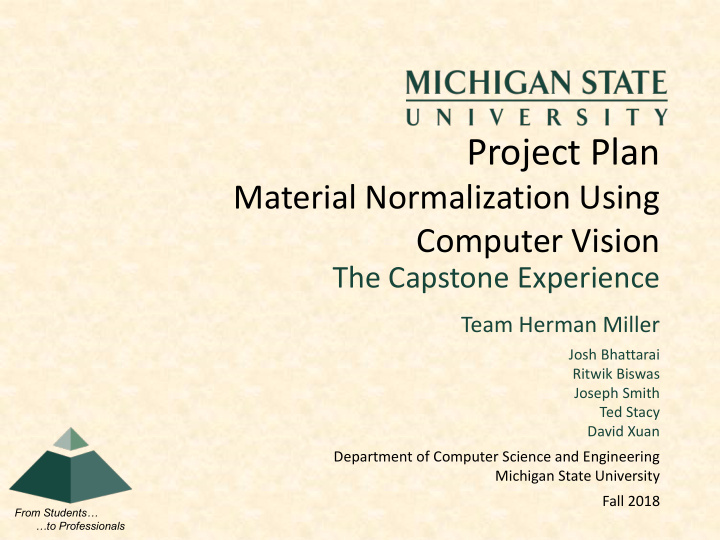



Project Plan Material Normalization Using Computer Vision The Capstone Experience Team Herman Miller Josh Bhattarai Ritwik Biswas Joseph Smith Ted Stacy David Xuan Department of Computer Science and Engineering Michigan State University Fall 2018 From Students… …to Professionals
Functional Specifications • Herman Miller needs an efficient way to normalize their fabric dataset • Currently, there is no process in place for sorting aesthetic/subjective categories • When Herman Miller receives a custom order with a proposed fabric, a manual search is done to find a Herman Miller fabric similar to the customers proposed fabric • Our system will create a predictive model to categorize newly acquired Herman Miller fabrics • Our predictive model will also be leveraged for categorizing a non-Herman Miller fabric, and suggesting Herman Miller fabrics that are similar The Capstone Experience Team Herman Miller Project Plan Presentation 2
Design Specifications • Our material normalization system contains three primary components: A predictive model to perform fabric categorization A web component to serve our predictive model as an API A user interface with the ability to upload fabric images, return the images categorization tags, and if applicable, return similar Herman Miller owned images The Capstone Experience Team Herman Miller Project Plan Presentation 3
Screen Mockup: Image Upload The Capstone Experience Team Herman Miller Project Plan Presentation 4
Screen Mockup: Classification The Capstone Experience Team Herman Miller Project Plan Presentation 5
Screen Mockup: Image Match The Capstone Experience Team Herman Miller Project Plan Presentation 6
Screen Mockup: Recommendations The Capstone Experience Team Herman Miller Project Plan Presentation 7
Technical Specifications • Color Classifier (79.0% accuracy) Color Adaboost Classifier (Decision tree base model) Trained it on 11,000 test images from Herman Miller We scan an input image by 3x3 pixel blocks and create a color distribution pattern • Pattern Classifier (84.4% accuracy) Used transfer learning to retrain the bottleneck layer of ImageNet Inception v3 (State of the art CNN image classifier) • Recommendation Engine Our engine will be able to compare user submitted images to fabrics in the database based on classification metadata The Capstone Experience Team Herman Miller Project Plan Presentation 8
Color Classification The Capstone Experience Team Herman Miller Project Plan Presentation 9
Color Classification The Capstone Experience Team Herman Miller Project Plan Presentation 10
Color Classification The Capstone Experience Team Herman Miller Project Plan Presentation 11
Color Classification The Capstone Experience Team Herman Miller Project Plan Presentation 12
Color Classification The Capstone Experience Team Herman Miller Project Plan Presentation 13
Color Classification The Capstone Experience Team Herman Miller Project Plan Presentation 14
Color Classification The Capstone Experience Team Herman Miller Project Plan Presentation 15
Color Classification The Capstone Experience Team Herman Miller Project Plan Presentation 16
System Architecture Flask Web Client The Capstone Experience Team Herman Miller Project Plan Presentation 17
System Components • Software Platforms / Technologies Amazon Web Services o S3 – Storage for training dataset o SageMaker – Makes use of Jupyter Notebooks instances running TensorFlow transfer learning network to train and deploy machine learning models o Lambda – Interfaces model endpoints o API Gateway – Endpoint for client requests Machine Learning o TensorFlow – Used for training neural network for pattern classification o Scikit-learn – Used for training RGB based color classification Flask o Client side framework used to interface with AWS GraphQL o A schema definition language used for querying their fabric database The Capstone Experience Team Herman Miller Project Plan Presentation 18
Risks • Inconsistent Tags The dataset that we are using to train our machine learning models have incorrect tags that will negatively affect models Solution: Create a script that will assist in manually retagging images in the dataset • API Efficiency Our API and classification models take a significant amount of time and the process needs to scale for batch classification Solution: Utilize asynchronous calls so the calls execute faster • Pattern Scale Feasibility ( Stretch Goal ) Herman Miller wants a categorization called pattern scale which is the size of the pattern on a fabric, which is near impossible to determine with the given constraints Solution: Look into EXIF or other image metadata that will determine scale or request scale in API, there are also other computer vision theories The Capstone Experience Team Herman Miller Project Plan Presentation 19
Questions? ? ? ? ? ? ? ? ? ? The Capstone Experience Team Herman Miller Project Plan Presentation 20
Recommend
More recommend